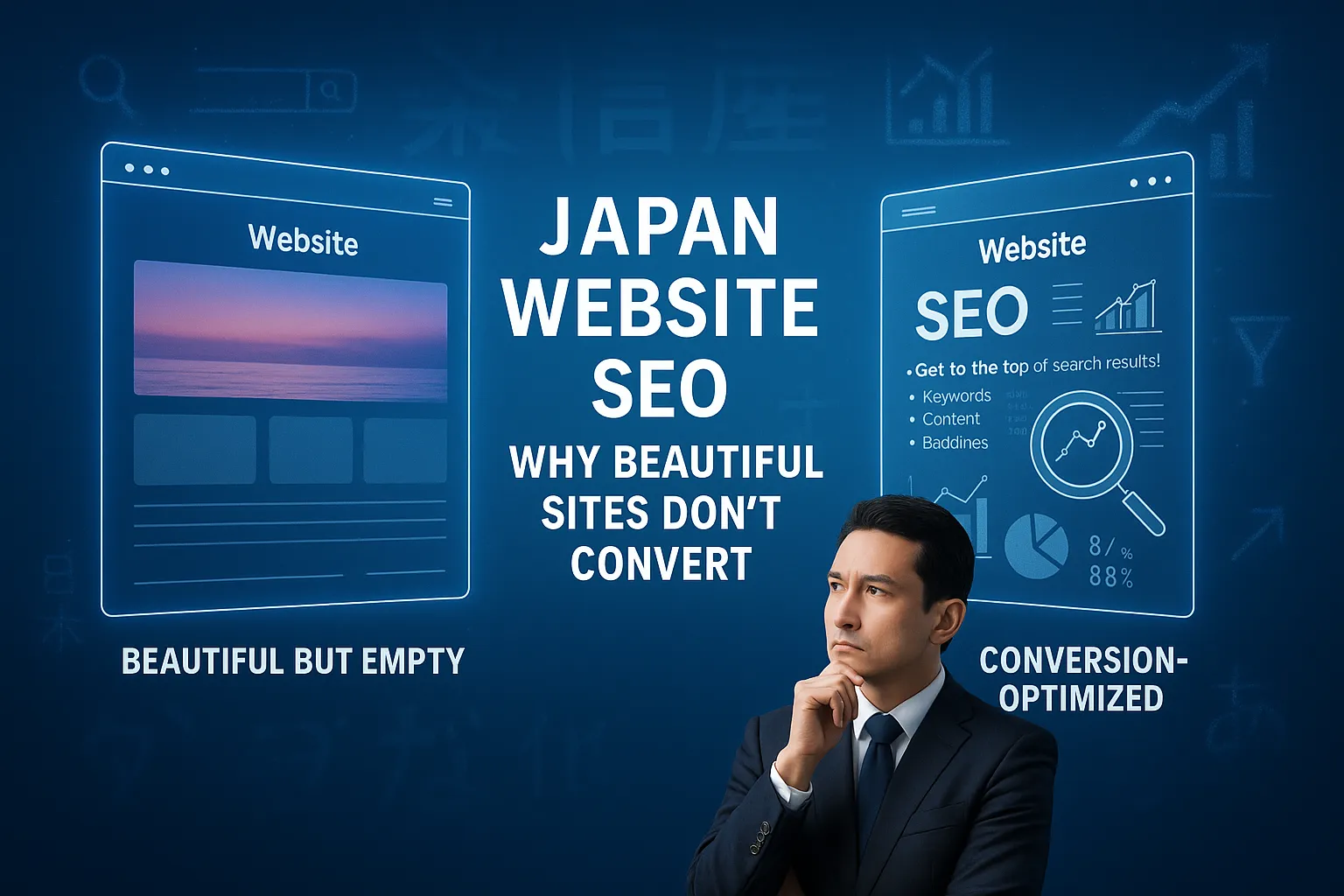- Introduction – When Design Alone Isn’t Enough
- 1. The Hidden Gap: Why “Beautiful” ≠ “Effective” in Japan
- 2. Language: The Foundation of Trust
- 3. Design: Subtle Adjustments Matter
- 4. SEO Structure: Why Local Search Behaves Differently
- 5. Conversion Path: Making Action Clear
- 6. Case Study Insights (Common Fixes)
- 7. How AI-Rental.jp Helps
- Conclusion – From Beautiful to Profitable
Introduction – When Design Alone Isn’t Enough
Many overseas companies entering Japan invest heavily in creating visually stunning websites.
Yet, they often face a frustrating reality: “the site looks great, but it doesn’t convert.”
Why does this happen?
The problem isn’t your technology or design skills. It’s often the language, cultural nuances, and local SEO structure that make the difference between a website that simply looks good and one that actually generates results.
In this article, we’ll explore why beautiful websites often fail in Japan — and more importantly, how to fix it.
1. The Hidden Gap: Why “Beautiful” ≠ “Effective” in Japan
Japanese users have unique expectations shaped by culture and business practices. Common reasons for underperformance include:
- Unnatural Japanese expressions: Direct translations from English often sound awkward or overly formal.
- Color and imagery mismatches: Photos, dress codes, or color palettes may look “off” in a Japanese business context.
- Information overload or lack of structure: Japanese users expect clarity, with key information upfront and well-organized.
- Heading structures not optimized for local search: English-style headings don’t align with Japanese keyword queries.
Without adjustments, even a visually impressive site feels foreign and untrustworthy.
2. Language: The Foundation of Trust
For Japanese audiences, natural Japanese wording is essential.
- Avoid literal translations that sound robotic.
- Use culturally appropriate levels of politeness and tone.
- Tailor CTAs (“お問い合わせはこちら” instead of “Contact Us”) to match expectations.
Key insight: In Japan, trust is built not only by design but by authentic, native-level communication.
3. Design: Subtle Adjustments Matter
Japanese users often prefer designs that balance clarity with modesty.
- Color choices: Avoid overly flashy palettes unless targeting youth or entertainment.
- Imagery: Photos should reflect realistic Japanese business environments.
- Whitespace: Japanese users are accustomed to denser information layouts; too much whitespace may feel “empty.”
The goal is not to abandon your design principles, but to localize the visual language to resonate with Japanese culture.
4. SEO Structure: Why Local Search Behaves Differently
Even if your design looks perfect, if it doesn’t rank, it won’t convert.
Key Japanese SEO differences:
- Keywords: Japanese queries often use shorter, more direct terms (e.g., “AIサービス 東京”).
- Headings (H1/H2/H3): Must reflect natural Japanese search intent, not just translated English headings.
- Meta descriptions: Google displays more characters in Japanese SERPs, so concise but informative summaries are crucial.
- Local signals: A .jp domain and Japanese hosting/IP boost trust and ranking.
Without these adjustments, your site risks being invisible, no matter how beautiful it looks.
5. Conversion Path: Making Action Clear
Japanese users prefer step-by-step clarity in calls to action.
- Multiple, visible CTAs throughout the page
- Clear explanation of next steps (inquiry → consultation → proposal)
- Use of trust-building phrases like “無料相談” (free consultation)
Remember: A well-localized conversion funnel can double or triple inquiry rates.
6. Case Study Insights (Common Fixes)
- Case 1: A SaaS company
Beautiful site with English headlines translated directly → Users bounced.
✅ Fix: Rewrote all copy in natural Japanese, improved inquiries by 250%. - Case 2: A consulting firm
Website used Western-style imagery (suits, bright colors) → Looked “foreign.”
✅ Fix: Updated visuals to Japanese-style business settings → Improved trust and engagement. - Case 3: An e-commerce brand
Navigation was minimalistic, too simple for Japanese shoppers.
✅ Fix: Expanded categories and detailed navigation → Increased session time by 40%.
7. How AI-Rental.jp Helps
Through our Japan Web Support Service, we bridge the gap between global design teams and Japanese users.
- Native copywriting for natural Japanese expressions
- Design reviews for cultural alignment
- SEO structures tailored to Japanese search behavior
- Cost-effective improvements without full rebuilds
Conclusion – From Beautiful to Profitable
A website that only looks good will not succeed in Japan.
But by aligning language, design, SEO structure, and conversion flow with local expectations, your site can transform into a trusted growth engine.
Take the next step to ensure your website is not just beautiful, but effective in Japan.
📩 Contact Us
https://www.airental.jp/inquiry/
For inquiries about AI domain leasing, .jp domain rental, and website localization for Japan.




コメント